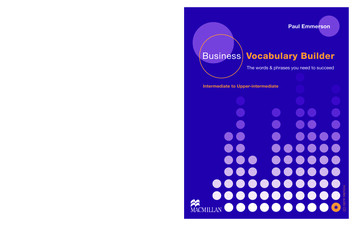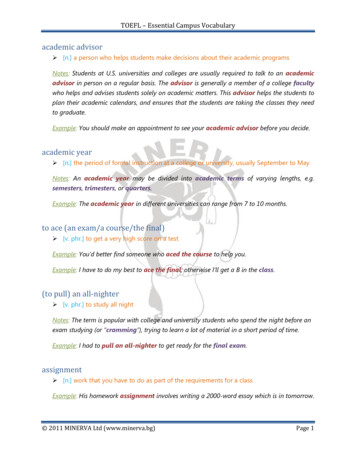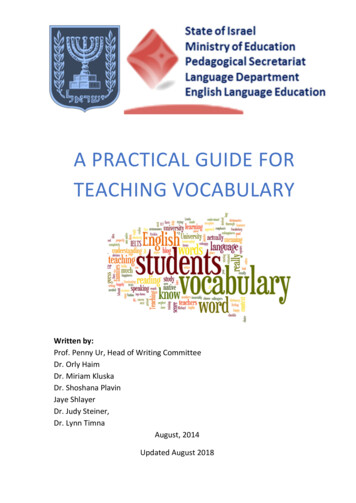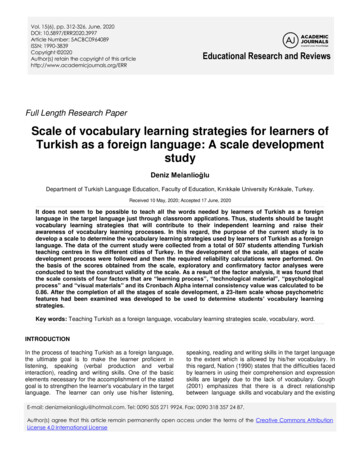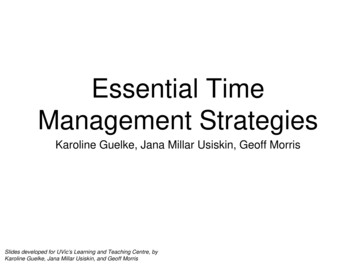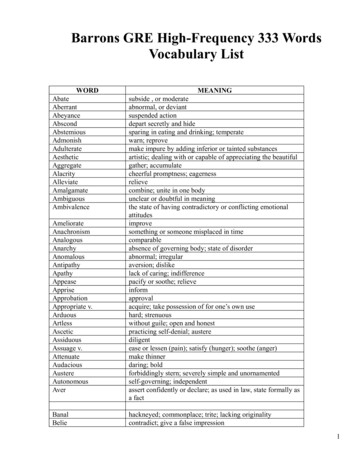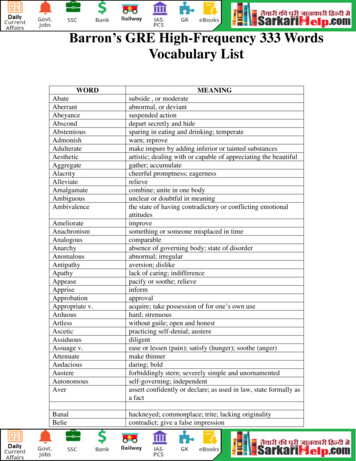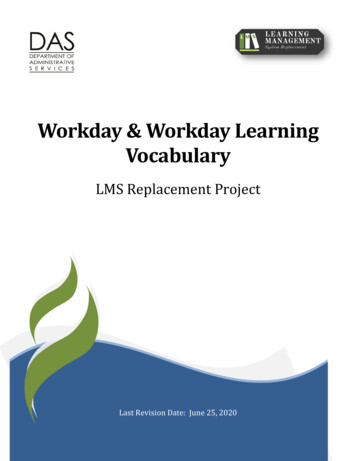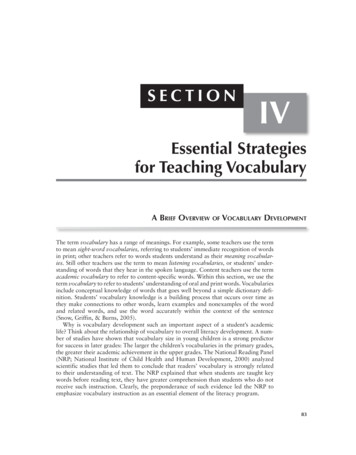
Transcription
SECTIONIVEssential Strategiesfor Teaching VocabularyA Brief OverviewofVocabulary DevelopmentThe term vocabulary has a range of meanings. For example, some teachers use the termto mean sight-word vocabularies, referring to students’ immediate recognition of wordsin print; other teachers refer to words students understand as their meaning vocabularies. Still other teachers use the term to mean listening vocabularies, or students’ understanding of words that they hear in the spoken language. Content teachers use the termacademic vocabulary to refer to content-specific words. Within this section, we use theterm vocabulary to refer to students’ understanding of oral and print words. Vocabulariesinclude conceptual knowledge of words that goes well beyond a simple dictionary definition. Students’ vocabulary knowledge is a building process that occurs over time asthey make connections to other words, learn examples and nonexamples of the wordand related words, and use the word accurately within the context of the sentence(Snow, Griffin, & Burns, 2005).Why is vocabulary development such an important aspect of a student’s academiclife? Think about the relationship of vocabulary to overall literacy development. A number of studies have shown that vocabulary size in young children is a strong predictorfor success in later grades: The larger the children’s vocabularies in the primary grades,the greater their academic achievement in the upper grades. The National Reading Panel(NRP; National Institute of Child Health and Human Development, 2000) analyzedscientific studies that led them to conclude that readers’ vocabulary is strongly relatedto their understanding of text. The NRP explained that when students are taught keywords before reading text, they have greater comprehension than students who do notreceive such instruction. Clearly, the preponderance of such evidence led the NRP toemphasize vocabulary instruction as an essential element of the literacy program.83
84 P r o m o t i n g L i t e r a c y D e v e l o p m e n tReflecting on the nature of children’s learning of words confirms the strong relationship between vocabulary and comprehension and calls attention to the prominent placethat vocabulary instruction should hold in the literacy program. Research related tovocabulary instruction and word knowledge shows that there is a robust correlationbetween knowing words and comprehending text (Beck, McKeown, & Kucan, 2008).Many educators feel that a strong vocabulary program just makes sense. Consider thatwords are labels for their meanings and when we know a word, we know what it represents. Some words are more complex than others, having multiple meanings, whileothers are conceptually rich and networked to countless other words. There are thosewords that may have different syntactic uses depending on their context within a sentence. For example, the word run can be used as a noun or a verb. Thus, learning a newword takes place over time. As students hear and read the word in many different contexts, their understanding and use of the word will develop and increase. Thus, thestudents within our classroom may have an understanding of a word, but the degree towhich they know a word may differ. The Partnership for Reading (2003) has used thefollowing three levels to describe students’ knowledge for word meanings: Unknown: The word is completely unfamiliar and its meaning is unknown. Acquainted: The word is somewhat familiar; the student has some idea of its basicmeaning. Established: The word is very familiar; the student can immediately recognize itsmeaning and use the word correctly. (p. 43)GuidelinesforTeaching VocabularyLearning words does not occur in a vacuum; that is, children do not acquire meanings ofwords in isolation. All learning—both personal and academic—occurs within the sociocultural environment of the home, community, and classroom. “Literacy is a social practice, so students learn academic vocabulary through social interactions as members of thelearning community” (Scott, Nagy, & Flinspach, 2008, p. 197). Therefore, effective teachers of language and literacy provide practices that stimulate rich uses of language, designing their instructional programs within a social context that promotes literacy learning.Teachers know that students who are learning to read and write and those who are reading to learn—that is, learning in content areas—will benefit from a sound instructionalvocabulary program. This is especially true for classrooms where children have smallvocabularies and are English language learners. Knowledge of words is acquired incidentally, where vocabulary is developed through immersion in language activities. Words arealso learned through direct instruction, where students learn words through a structuredapproach. Thus, vocabulary programs should be designed to support children’s word learning through a combination of approaches to teaching, direct instruction, and incidentalword learning. Michael Graves (2006) offers a framework for successful vocabulary programs that supports effective teaching and students’ development of word knowledge. Thefoundation of his instructional program includes a four-part approach to developing robustvocabularies: (1) Provide rich and varied language experiences, (2) teach individual words,(3) teach word-learning strategies, and (4) foster word consciousness (pp. 4–8).Providing rich and varied language experiences: Incidental word learning takes placewhen teachers offer and encourage students to participate in a variety of rich languageexperiences that occur throughout the day and across the curriculum. Examples of suchexperiences that promote rich and powerful vocabularies at all grade levels include
Strategy IV Essential Strategies for Teaching Vocabulary 85(1) interactive read-alouds of outstanding children’s literature, (2) dialogic-basedinstructional activities, (3) independent reading, (4) interactive writing, and (5) creatinga print-rich environment where the “walls are dripping with words.”Teaching individual words: Although many words may be learned incidentally andvocabularies do become stronger when they are supported with a language-rich environment, children benefit from systematic and direct instruction of words. The research isclear with respect to effective teaching of words (Graves, 2006). Vocabulary instructionshould (1) provide students with information that contains the context as well as themeaning of the word, (2) design instruction that engages students and allows sufficienttime for word learning, (3) make sure students have multiple exposures to the wordswith review and practice, and (4) create a dialogue around the words.Teaching word-learning strategies: An important aspect of developing students’ robustvocabularies is teaching them tools to unlock the meaning of unknown words. The mosteffective tools use the context of the surrounding words or sentences to infer the meaning of a word, using meaningful word parts to make sense out of the unknown wordand using the dictionary effectively to help define an unknown word.Building word consciousness in readers and writers: An important aspect of a strongvocabulary program is to engage students in learning new words. As teachers, we needto develop word consciousness within our students and maintain their interest in words.Graves and Watts-Taffe (2008) suggest that teachers “(1) create a word-rich environment, (2) recognize and promote adept diction, (3) promote word play, (4) foster wordconsciousness through writing, (5) involve students in original investigations, and(6) teach students about words” (p. 186).A StrategyforAssessing Vocabulary DevelopmentAssessing student learning is a critical component of effective teaching and achievement.Therefore, part of the teacher’s literacy instructional plan needs to include the assessment of students’ vocabulary development. We aligned our progress monitoring ofvocabulary with the following instructional goals: (1) to enhance vocabulary development and use, (2) to develop word-learning strategies, and (3) to build word consciousness. One approach in assessing students’ vocabulary development is through the use ofthe rubric in Figure IV.1. The rubric contains six criteria related to the goals of thevocabulary instructional program. By monitoring students’ progress, teachers may usethe results to modify their instruction to meet the needs of individual students, those ofthe class, and the instructional program.Figure IV.1 Rubric for Assessing Vocabulary DevelopmentCriterionWord identificationLevel #3Advanced(3 Points)The student is proficientin saying, reading, orwriting the word.Level #2Developing(2 Points)Level #1Striving(1 Point)The student has somedifficulty saying, reading,or writing the word.The student has a lot ofdifficulty saying, reading,or writing the word.(Continued)
86 P r o m o t i n g L i t e r a c y D e v e l o p m e n t(Continued)Word meaningThe student knows thecomprehensive meaningof the word and candiscuss multiplemeanings of the word.The student knows apartial meaning of theword but has difficultydiscussing a full meaningof the word.The student does notknow the meaning of theword and cannot discussit.Reading the wordThe student offers a richexplanation of thecontextual meaning ofthe word.The student offers apartial explanation of thecontextual meaning ofthe word.The student is not ableto explain the contextualmeaning of the word.Writing the wordThe student uses theword with a high degreeof accuracy within thecontext of writing.The student uses theword with some degreeof accuracy within thecontext of writing.The student does notattempt to use the wordwithin the context ofwriting.Word-learningstrategiesThe student uses arange of word-learningstrategies, along withvaried resources, tolearn new words.The student uses fewword-learning strategiesand resources to learnnew words.The student does notuse word-learningstrategies and resourcesto learn new words.Word consciousnessThe studentdemonstrates anawareness and interestin learning and usingnew words.The studentdemonstrates a minimalawareness and interestin learning and usingnew words.The student does notdemonstrate anawareness and interestin learning and usingnew words.Advanced level18–13 pointsDeveloping level12–7 pointsStriving level6–0 pointsOverall level ofvocabularydevelopmentA GuideforUsing Responseto Intervention forVocabularyWord knowledge is more than just reading a word! As we have discussed in this section,knowing words is multidimensional and the process occurs over time. Therefore, effective instruction and assessment in vocabulary will take into account the students’ development in reading words correctly, knowing the meaning of a word within severaldifferent contexts, using words in reading as well as writing, using word-learning strategies, and being word conscious. The rubric in Figure IV.1 provides a multidimensionalapproach to assess word learning that teachers may use to monitor students’ vocabularydevelopment in reading and writing. As teachers apply the rubric for evaluating students’ performances, they will see patterns emerge in each of these areas that needimprovement and may use the results for selecting a Response to Intervention strategy.For example, one teacher of students with special needs analyzed the assessment resultsand found that four students were not “word conscious.” The students had little or noawareness of new and exciting words, and their lack of a positive disposition for wordshindered their vocabulary development. The teacher used these results for selecting aResponse to Intervention strategy. She chose and implemented the Vocabulary SelfCollection strategy and found there was an overall difference in her students’ stancetoward learning new words.
Strategy IV Essential Strategies for Teaching Vocabulary 87Professional ResourcesAllen, J. (2004). Inside words: Tools for teaching academic vocabulary, grades 4–12. Portland, ME:Stenhouse.Baumann, J. F., & Kame’enui, E. J. (Eds.). (2004).Vocabulary instruction: Research to practice. NewYork: Guilford.Brand, M. (2004). Word savvy: Integrated vocabulary,spelling, and word study, grades 3–6. Portland, ME:Stenhouse.Frey, N., & Fisher, D. (2009). Learning words inside and out,grades 1–6: Vocabulary instruction that boosts achievement in all subject areas. Portsmouth, NH: Heinemann.ReferencesBeck, I. L., McKeown, M. G., & Kucan, L. (2008).Creating robust vocabulary: Frequently asked questions and extended examples. New York: Guilford.Graves, M. F. (2006). The vocabulary book: Learningand instruction. New York: Teachers College Press.Graves, M. F., & Watts-Taffe, S. (2008). For the love ofwords: Fostering word consciousness in young readers. The Reading Teacher, 62(3), 185–193.National Institute of Child Health and HumanDevelopment. (2000). Report of the National ReadingPanel. Teaching children to read: An evidence-basedassessment of the scientific research literature on reading and its implications for reading instruction (NIHPublication No. 00-4769). Washington, DC: U.S.Government Printing Office.Partnership for Reading. (2003). Put reading first: Theresearch building blocks of reading instruction, kindergarten through grade 3. (2nd ed.). Washington,DC: Author.Scott, J. A., Nagy, W. E., & Flinspach, S. L. (2008). Morethan merely words: Redefining vocabulary learning in aculturally and linguistically diverse society. In A. E.Farstrup & S. J. Samuels (Eds.), What research has tosay about vocabulary instruction (pp. 182–210).Newark, DE: International Reading Association.Snow, C. E., Griffin, P., & Burns, M. S. (Eds.). (2005).Knowledge to support the teaching of reading:Preparing teachers for a changing world. SanFrancisco: Jossey-Bass.
g Briefly: An Overviewof theLiteracy StrategyThe Vocabulary Self-Collection strategy (VSS) is an interacti
vocabulary with the following instructional goals: (1) to enhance vocabulary develop-ment and use, (2) to develop word-learning strategies, and (3) to build word conscious- ness. One approach in assessing students’ vocabulary development is through the use of the rubric in Figure IV.1. The rubric contains six criteria related to the goals of the vocabulary instructional program. By .
